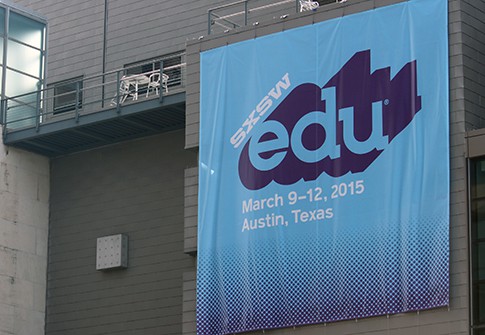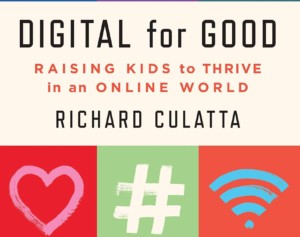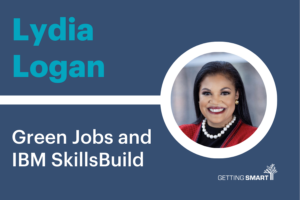SXSWedu: Design Thinking, Learning, and Teaching

Moss Pike
As was the case at SXSWedu last year, design thinking was again a very popular topic at this year’s conference, with no less than six formal sessions offered on design practice within education. Since SXSWedu does such a fantastic job of bringing educators together with entrepreneurs who are excited to share their own nascent ideas, it is no surprise that design and innovation have become a driving force behind much of the conversations here in Austin.
Thanks to the mutual exchange of ideas, both within and outside of sessions at SXSWedu, more educators are starting to embrace the possibilities and new thinking that entrepreneurs can add to the conversation, in taking on more of a design mindset. Below are just a few of the several conference design-based highlights.
Living @scitechyEDU this afternoon by hacking our #SXSWedu room from “campfire” chairs to small groups! #dtk12chat pic.twitter.com/RMiK5MdWuQ
— Margaret A Powers (@mpowers3) March 9, 2015
Our leader defined map (lack of vision) from @LindseyOwn & @mpowers3 #SXSWedu session- drawings by @WickedDecent pic.twitter.com/hVg3nHVACz
— Jessica Lura (@msjlura) March 9, 2015
Lindsey Own and Maggie Powers led Scaling Innovation in Schools: New Leadership Roles.They encouraged participants to discuss roadblocks to innovation, while working toward a more effective model of leadership. Participants built empathy maps, after using the “Five Whys” method to drill down on the root causes of some of the more common problems standing in the way of innovation at their schools, among which include the “silo effect” of our organizations, insufficient time and space, and a lack of vision leading the school. The session closed by writing a job description for the leadership role needed, which participants discussed with each other. It was no surprise that, despite starting with different problems, our job descriptions were remarkably uniform in needs and responsibilities.
Shaking it out with these #dtk12chat homies #SXSWedu #boomshakalaka pic.twitter.com/qGOGEjpvh5
— Isis Stephanie Cerda (@Ms_Cerda) March 10, 2015
In Design Thinking the Humanities: K-12, Ashley Auspelmyer, Ellen Deutscher, Amanda Kruysman, and Dan Ryder presented a number of ideas for using design thinking in the K12 Humanities classroom, focusing on using empathy to solve problems with design projects focusing on authentic problems. For example, doing intentional literary analysis from the perspective of the author, building a global mindset within our communities, and being more aware of issues involving social justice. In the session, Ashley reminded everyone that design thinking isn’t supposed to make anything easier, but it does make our work more joyful and meaningful.
In complement to the “pure” sessions on design and design thinking in education given at SXSWedu, Jen Oleniczak led Improv(e) Your Teaching that focused on using improv comedy skills within education. In particular, she took her participants through a series of activities that built supportive and engaging “Yes, and…” communities in both classrooms and larger school organizations, including building chain stories together and building a story in which each participant took turns offering a “Yes, and…” to their group’s story ideas. One of the foundational ideas in Jen’s session was active listening that improv comedy skills demand: by thinking more like an improvisor, we can learn how to actively listen to each other more effectively.
Checking out the @InnovateNYCedu #SharkTankEDU event at @CFStartupEvents! @leapinchicago @cvefoundation #SXSWedu2015 pic.twitter.com/q8ngaxlkCA — EdTech Austin (@EdTechAustin) March 10, 2015
#SharkTankEDU, hosted by the Capital Factory in Austin on Tuesday night, was one of the highlights of the conference that illustrated this emerging partnership between educators and entrepreneurs. In the event, entrepreneurs gave a short demo of a product in front of a panel of educators, who then offered valuable feedback to help improve the product’s value proposition within the education space. Not only did each entrepreneur receive the kinds of feedback that they needed to continue developing their ideas, but educators also had the opportunity to learn more about the ideas that entrepreneurs are developing.
This is only a snippet of the crowd here right now! #dtk12chat #SXSWedu pic.twitter.com/ec4C3KHKI4 — Moss Pike (@mosspike) March 12, 2015
Finally, the #dtk12chat Twitter community was represented in force at SXSWedu. They hosted a live Twitter discussion that discussed the interface between educators and entrepreneurs and the “disruptive” effect that each side can create for one another. True to form, the mob attracted quite a crowd and disrupted the flow of traffic through the Hilton lobby. The discussion (cf. the Storify chat digest) was challenging, in that it echoed the idea that the educator-entrepreneur relationship and the human-centered design opportunities that it will bring deserve further exploration.
If someone asked for a single word to describe SXSWedu, it would be “disruptive.” Based on the kinds of people who gathered in Austin for the event. The mutual design opportunities that conference attendees created for each other infused the entire week’s conversations, formally and informally. Thanks to what will hopefully be a long and mutually beneficial relationship between educators and our larger communities—and especially entrepreneurs who work in education—design and design thinking will continue to be a driving force behind the conversations that happen at SXSWedu.






0 Comments
Leave a Comment
Your email address will not be published. All fields are required.